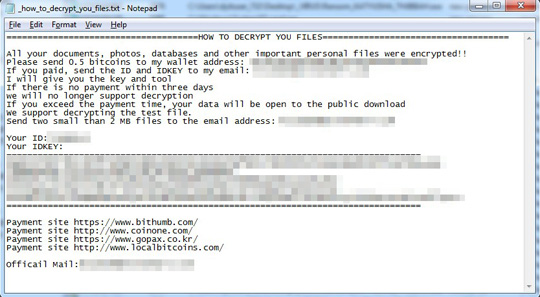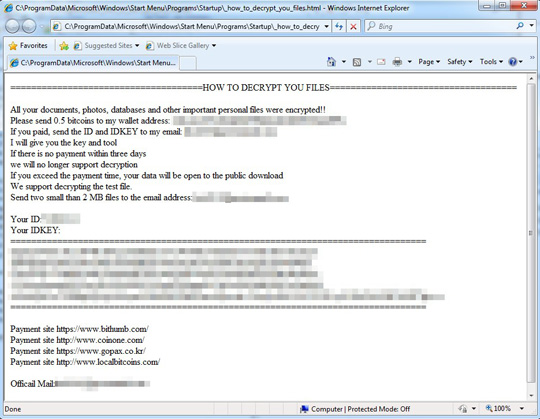RANSOM_KATYUSHA.THJBBAH
W32/Katyusha.585A!tr.ransom (Fortinet); Ransom.Katyusha (Malwarebytes)
Windows


Threat Type: Ransomware
Destructiveness: No
Encrypted: Yes
In the wild: Yes
OVERVIEW
Downloaded from the Internet, Dropped by other malware
This Ransomware arrives on a system as a file dropped by other malware or as a file downloaded unknowingly by users when visiting malicious sites.
It executes then deletes itself afterward.
It is capable of encrypting files in the affected system.
TECHNICAL DETAILS
336,384 bytes
EXE
No
22 Oct 2018
Encrypts files, Drops files, Displays message/message boxes, Terminates processes
Arrival Details
This Ransomware arrives on a system as a file dropped by other malware or as a file downloaded unknowingly by users when visiting malicious sites.
Installation
This Ransomware drops the following files:
- {Malware Path}\pub.key → contains the computers' public key
- {Malware Path}\svchost.bat → contains the code that deletes the ransomware and itself
It adds the following processes:
- %System%\cmd.exe /c vssadmin delete shadows /all /quiet&vssadmin delete shadows /all /quiet
- "%System%\NOTEPAD.EXE" %System Root%\_how_to_decrypt_you_files.txt
- "%Program Files%\Internet Explorer\iexplore.exe" %ProgramData%/_how_to_decrypt_you_files.txt
- cmd /c ""{Malware Path}\svchost.bat" "
(Note: %System% is the Windows system folder, where it usually is C:\Windows\System32 on all Windows operating system versions.. %System Root% is the Windows root folder, where it usually is C:\ on all Windows operating system versions.. %ProgramData% is a version of the Program Files folder where any user on a multi-user computer can make changes to programs. This contains application data for all users. This is usually C:\ProgramData in Windows Vista, 7, and 8.)
It executes then deletes itself afterward.
Other Details
This Ransomware does the following:
- It drops the following ransom note into the Windows Common Startup folder:
- %Common Startup%\_how_to_decrypt_you_files.txt

- %Common Startup%\_how_to_decrypt_you_files.html

- %Common Startup%\_how_to_decrypt_you_files.txt
- It drops the following files as ransom note:
- %System Root%\_how_to_decrypt_you_files.txt
- %ProgramData%\_how_to_decrypt_you_files.txt
- It avoids encrypting files with specific strings in folder path:
- AUTOEXEC.BAT
- bootfont.bin
- NTDETECT.COM
- \!!
- \$$
- \%%
- \AhnLab\
- \Avast\
- \AVG\
- \Avira\
- \boot.ini
- \bootmgr
- \BOOTSECT
- \Boot\
- \Chrome\
- \Common Files\
- \COMODO\
- \desktop.ini
- \document.docc
- \DrWeb\
- \DVD Maker\
- \endendend
- \ESET\
- \ESTsoft\
- \hancom.hwp
- \image.jpg
- \Internet Explorer\
- \Kaspersky Lab\
- \McAfee\
- \Microsoft Games\
- \Microsoft Help\
- \Microsoft Security Client\
- \Microsoft Shared\
- \MicrosoftNET\
- \Microsoft\
- \Movie Maker\
- \Mozilla Firefox\
- \netmeeting\
- \ntldr
- \ntldr\
- \NTUSER.DAT
- \ntuser.ini
- \NVIDIA Corporation\
- \Opera\
- \Outlook Express\
- \pagefile\
- \ProgramData\
- \Recovery\
- \Recycle
- \Sample Music\
- \Sample Pictures\
- \Sample Videos\
- \Searches\
- \session\
- \spytech software\
- \svchost
- \Symantec\
- \Symantec_Client_Security\
- \sysconfig\
- \system volume information\
- \Temp\
- \Text.txt
- \Windows App Certification Kit\
- \Windows Defender\
- \Windows Kits\
- \Windows Mail\
- \Windows Media Player\
- \Windows Multimedia Platform\
- \Windows NT\
- \Windows Phone Kits\
- \Windows Phone Silverlight Kits\
- \Windows Photo Viewer\
- \Windows Portable Devices\
- \Windows Sidebar\
- \WindowsPowerShell\
- \Windows\
- \WINDOWS\
- \Wsus\
- \YandexBrowser\
- \_how_to_decrypt_you_files.html
- \_how_to_decrypt_you_files.txt
- It avoids encrypting files with the following extensions:
- .dll
- .exe
- .ios
- .katyusha
- .lnk
- .SYS
- .sys
- .url
- It terminates the following processes using the command "%System%\cmd.exe /c taskkill /F /IM {Process name}":
- mysqld.exe
- httpd.exe
- sqlservr.exe
- sqlwriter.exe
- w3wp.exe
- sqlagent.exe
- fdhost.exe
- fdlauncher.exe
- reportingservicesservice.exe
- omtsreco.exe
- tnslsnr.exe
- oracle.exe
- emagent.exe
- mysqld-nt.exe
It is capable of encrypting files in the affected system.
Ransomware Routine
This Ransomware appends the following extension to the file name of the encrypted files:
- .katyusha
SOLUTION
9.850
14.580.03
22 Oct 2018
14.581.00
23 Oct 2018
Step 1
Before doing any scans, Windows XP, Windows Vista, and Windows 7 users must disable System Restore to allow full scanning of their computers.
Step 2
Note that not all files, folders, and registry keys and entries are installed on your computer during this malware's/spyware's/grayware's execution. This may be due to incomplete installation or other operating system conditions. If you do not find the same files/folders/registry information, please proceed to the next step.
Step 3
Search and delete this file
- {Malware Path}\pub.key
- {Malware Path}\svchost.bat
- %Common Startup%\_how_to_decrypt_you_files.txt
- %Common Startup%\_how_to_decrypt_you_files.html
- %System Root%\_how_to_decrypt_you_files.txt
- %ProgramData%\_how_to_decrypt_you_files.txt
Step 4
Scan your computer with your Trend Micro product to delete files detected as RANSOM_KATYUSHA.THJBBAH. If the detected files have already been cleaned, deleted, or quarantined by your Trend Micro product, no further step is required. You may opt to simply delete the quarantined files. Please check the following Trend Micro Support pages for more information:
Step 5
Restore encrypted files from backup.
Did this description help? Tell us how we did.
